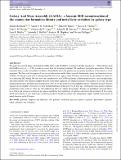Files in this item
Galaxy And Mass Assembly (GAMA) : a forensic SED reconstruction of the cosmic star formation history and metallicity evolution by galaxy type
Item metadata
| dc.contributor.author | Bellstedt, Sabine | |
| dc.contributor.author | Robotham, Aaron S. G. | |
| dc.contributor.author | Driver, Simon P. | |
| dc.contributor.author | Thorne, Jessica E. | |
| dc.contributor.author | Davies, Luke J. M. | |
| dc.contributor.author | Lagos, Claudia del P. | |
| dc.contributor.author | Stevens, Adam R. H. | |
| dc.contributor.author | Taylor, Edward N. | |
| dc.contributor.author | Baldry, Ivan K. | |
| dc.contributor.author | Moffett, Amanda J. | |
| dc.contributor.author | Hopkins, Andrew M. | |
| dc.contributor.author | Phillipps, Steven | |
| dc.date.accessioned | 2020-12-07T15:59:16Z | |
| dc.date.available | 2020-12-07T15:59:16Z | |
| dc.date.issued | 2020-11 | |
| dc.identifier | 271521355 | |
| dc.identifier | c2816ef1-0282-41c3-b10c-3e519b835171 | |
| dc.identifier | 000587755500073 | |
| dc.identifier | 85095849904 | |
| dc.identifier.citation | Bellstedt , S , Robotham , A S G , Driver , S P , Thorne , J E , Davies , L J M , Lagos , C D P , Stevens , A R H , Taylor , E N , Baldry , I K , Moffett , A J , Hopkins , A M & Phillipps , S 2020 , ' Galaxy And Mass Assembly (GAMA) : a forensic SED reconstruction of the cosmic star formation history and metallicity evolution by galaxy type ' , Monthly Notices of the Royal Astronomical Society , vol. 498 , no. 4 , pp. 5581-5603 . https://doi.org/10.1093/mnras/staa2620 | en |
| dc.identifier.issn | 0035-8711 | |
| dc.identifier.uri | https://hdl.handle.net/10023/21113 | |
| dc.description | SB and SPD acknowledge support by the Australian Research Council’s funding scheme DP180103740. | en |
| dc.description.abstract | We apply the spectral energy distribution (SED) fitting code PROSPECT to multiwavelength imaging for similar to 7000 galaxies from the GAMA survey at z <0.06, in order to extract their star formation histories. We combine a parametric description of the star formation history with a closed-box evolution of metallicity where the present-day gas-phase metallicity of the galaxy is a free parameter. We show with this approach that we are able to recover the observationally determined cosmic star formation history (CSFH), an indication that stars are being formed in the correct epoch of the Universe, on average, for the manner in which we are conducting SED fitting. We also show the contribution to the CSFH of galaxies of different present-day visual morphologies and stellar masses. Our analysis suggests that half of the mass in present-day elliptical galaxies was in place 11 Gyr ago. In other morphological types, the stellar mass formed later, up to 6 Gyr ago for present-day irregular galaxies. Similarly, the most massive galaxies in our sample were shown to have formed half their stellar mass by 11 Gyr ago, whereas the least massive galaxies reached this stage as late as 4 Gyr ago (the well-known effect of 'galaxy downsizing'). Finally, our metallicity approach allows us to follow the average evolution in gas-phase metallicity for populations of galaxies and extract the evolution of the cosmic metal mass density in stars and in gas, producing results in broad agreement with independent, higher redshift observations of metal densities in the Universe. | |
| dc.format.extent | 23 | |
| dc.format.extent | 4173714 | |
| dc.language.iso | eng | |
| dc.relation.ispartof | Monthly Notices of the Royal Astronomical Society | en |
| dc.subject | Galaxies: elliptical and lenticular, cD | en |
| dc.subject | Galaxies: evolution | en |
| dc.subject | Galaxies: general | en |
| dc.subject | Galaxies: photometry | en |
| dc.subject | Galaxies: spiral | en |
| dc.subject | Galaxies: star formation | en |
| dc.subject | QC Physics | en |
| dc.subject | QB Astronomy | en |
| dc.subject | DAS | en |
| dc.subject.lcc | QC | en |
| dc.subject.lcc | QB | en |
| dc.title | Galaxy And Mass Assembly (GAMA) : a forensic SED reconstruction of the cosmic star formation history and metallicity evolution by galaxy type | en |
| dc.type | Journal article | en |
| dc.contributor.institution | University of St Andrews. School of Physics and Astronomy | en |
| dc.identifier.doi | https://doi.org/10.1093/mnras/staa2620 | |
| dc.description.status | Peer reviewed | en |
| dc.identifier.url | https://arxiv.org/abs/2005.11917 | en |
This item appears in the following Collection(s)
Items in the St Andrews Research Repository are protected by copyright, with all rights reserved, unless otherwise indicated.

